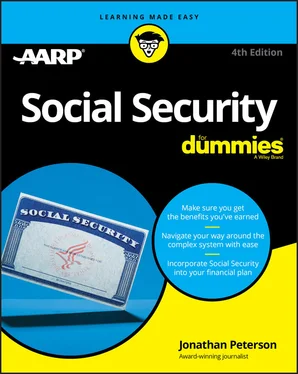2014: The Social Security Administration began to process and approve some claims for benefits related to same-sex marriage, including claims for spousal and survivor benefits in states that recognize such unions as legal. The new policy followed a U.S. Supreme Court ruling in 2013 that Section 3 of the Defense of Marriage Act was unconstitutional.
2015: The Supreme Court ruled that same-sex marriages have a constitutional right in all states. The SSA recognizes same-sex marriage in all states and gives benefits to spouses.
Understanding How You Pay for Social Security
Social Security is paid for through taxes. (No surprise there.) But you’re not the only one paying into the Social Security pot: Your employer also pays a portion of your Social Security tax. All that money that’s taken out of your paycheck today goes to pay the benefits for today’s retirees.
For the lowdown on how much you pay into Social Security and where it goes, read on.
If you’re a wage earner, you pay into the Social Security system straight out of your paycheck. This payroll tax is dubbed “FICA,” which stands for the Federal Insurance Contributions Act. The Social Security portion of your payroll tax is typically 6.2 percent of earnings up to a certain amount, which is adjusted annually (for 2020, the cap was set at $137,700). Employers also pay 6.2 percent for each employee. In addition, workers and their employers each pay 1.45 percent of all earnings for Medicare’s Hospital Insurance Trust Fund. As of January 2013, individuals who earn more than $200,000 ($250,000 for married couples filing jointly) pay an additional 0.9 percent in Medicare taxes.
 If you’re self-employed, you’re on the hook for both the employee and employer share, which usually adds up to 12.4 percent for Social Security and 2.9 percent for Medicare. This tax is dubbed “SECA,” for the Self-Employed Contributions Act.
If you’re self-employed, you’re on the hook for both the employee and employer share, which usually adds up to 12.4 percent for Social Security and 2.9 percent for Medicare. This tax is dubbed “SECA,” for the Self-Employed Contributions Act.
Politicians have been willing to ease the payroll-tax burden in response to economic conditions. In 2011, Congress approved a “payroll-tax holiday” to boost the economy; it lowered the worker’s tax rate to 4.2 percent instead of the usual 6.2 percent. Employers still paid the usual 6.2 percent. The self-employed paid an overall rate of 10.4 percent. (The payroll-tax holiday expired at the end of 2012.)
Most workers pay Social Security taxes on all their earnings, because most workers don’t earn above the cap for Social Security payroll taxes. Well more than half — maybe three-quarters — of U.S. households pay more in Social Security taxes than in federal income taxes. Although no one enjoys paying taxes, people tend to accept the Social Security tax because it enables them to earn important benefits.
The taxes you pay in your working years pay for the benefits for retirees and other beneficiaries who no longer are working. This approach is called “pay as you go.” Think of it as a pipeline that goes from current workers to current beneficiaries.
What the government does with your payroll tax contributions has long been a source of rumor, misunderstanding, and strongly held views. Here are the facts: The Social Security payroll tax deducted from your wages goes into two U.S. Treasury accounts, where it’s used to pay for benefits. Most of the money — about 85 percent — goes into the Old-Age and Survivors Insurance Trust Fund; the remainder goes into the Disability Insurance Trust Fund. These combined trust funds are quite large, with assets of slightly more than $2.9 trillion at the end of 2018.
Tax revenues above and beyond what’s needed to pay benefits are invested in special Treasury securities. These bonds have historically provided extra income for Social Security. Some critics argue that the trust funds could go belly up if the Treasury doesn’t make good on its borrowing. But these bonds are backed by the full faith and credit of the U.S. government, which is still considered a safe investment by investors all over the world.
Although Social Security gets most of its income from payroll taxes, a smaller share comes from interest and some income tax revenues paid by the affluent on their Social Security benefits. (See Chapter 13for a discussion of income taxes and Social Security.)
Large as the trust funds are, they’re going to shrink rapidly in the future. Today, more than 47 million Americans are age 65 and older. Does that sound like a lot of older people? Just wait. That number will soar beyond 80 million in the coming decades, bringing vastly higher demand for Social Security benefits. Today, there are 2.8 workers for each person getting Social Security. But by 2035 just 2.3 workers will support each beneficiary, and revenue no longer will be sufficient to fully pay for promised benefits, meaning that revenue won’t be able to keep up with benefits. The pay-as-you-go approach will come under increasing pressure, with proportionately fewer workers to support a great many beneficiaries. The trust funds are forecast to run out of money at about that time.
Although that’s a problem that must be addressed, it’s not as grim as it may sound. The SSA gets most of its revenue from payroll taxes. Even if the trust funds were somehow allowed to dry up, an extremely large amount of money would continue to flow through the system, paying most of what is currently promised.
Keep that in mind, especially if you wonder whether Social Security will be there for you down the road. Social Security should be able to pay three-quarters of promised benefits, even when it no longer has a surplus and if no action is taken. (That’s according to the Social Security trustees, who report annually on the system’s long-term outlook.)
If you’re like most people, you probably believe that the system requires long-term financial stability. But the idea that the SSA can cover three-fourths of promised benefits far into the future gives at least some perspective. With enough political will, lawmakers can put their heads together and come up with a fair and reasonable plan to shore up Social Security for the long term. (In Chapter 17, you can look at the most common proposals to accomplish this goal.)
Getting the Most Out of Your Social Security Benefits
 Today’s workers will need all the retirement security they can muster in old age, and for most people Social Security is the centerpiece. Here are some things you can do today to get the most out of Social Security tomorrow:
Today’s workers will need all the retirement security they can muster in old age, and for most people Social Security is the centerpiece. Here are some things you can do today to get the most out of Social Security tomorrow:
Educate yourself about the program. By reading this book, you’re taking a big step in the right direction. In Appendix B, I connect you with a broader range of resources to further inform you on Social Security and other retirement concerns.LESSONS FROM AN EARLY BENEFICIARYWhatever you expect to get from Social Security, it’s a pretty safe bet you won’t fare as well as Aunt Ida. A retired legal secretary in Vermont, Ida May Fuller, known to friends as “Aunt Ida,” earned her place in Social Security history by receiving the first recurring monthly check — for $22.54 on January 31, 1940. (It wasn’t the first Social Security payment. That distinction goes to a Cleveland streetcar driver named Ernest Ackerman, who got a “lump sum” of 17 cents three years earlier.)Aunt Ida’s experience can teach today’s retirees (and workers who will join them one day) a couple of lessons:You could be depending on Social Security for a very long time. Aunt Ida lived to 100. She collected benefits for 35 years, starting at age 65.The inflation protection provided by Social Security is critical. In the course of Aunt Ida’s life, her monthly benefit nearly doubled, from $22.54 to $41.30. That increase enabled her purchasing power to hold up, even as the cost of living soared. (Congress added regular inflation increases to the program toward the end of Aunt Ida’s life.)
Читать дальше

 If you’re self-employed, you’re on the hook for both the employee and employer share, which usually adds up to 12.4 percent for Social Security and 2.9 percent for Medicare. This tax is dubbed “SECA,” for the Self-Employed Contributions Act.
If you’re self-employed, you’re on the hook for both the employee and employer share, which usually adds up to 12.4 percent for Social Security and 2.9 percent for Medicare. This tax is dubbed “SECA,” for the Self-Employed Contributions Act. Today’s workers will need all the retirement security they can muster in old age, and for most people Social Security is the centerpiece. Here are some things you can do today to get the most out of Social Security tomorrow:
Today’s workers will need all the retirement security they can muster in old age, and for most people Social Security is the centerpiece. Here are some things you can do today to get the most out of Social Security tomorrow:










